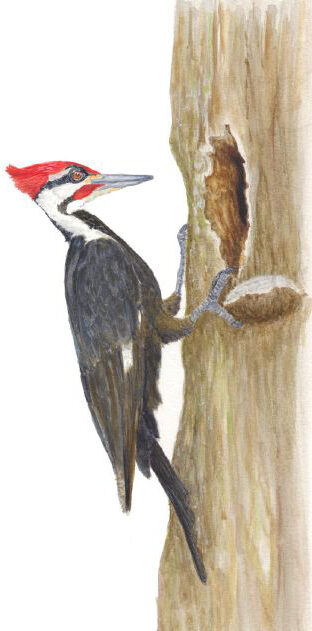Spring Is In The Air
Spring Is In The Air
The following appeared in the Spring 2023 issue of Adirondac Magazine
By Audrey Hyson
The activity of our year-round resident birds and mammals increases noticeably as the days lengthen and the snow recedes in early spring. Warm days find chipmunks venturing out of their underground burrows to feast on sunflower seeds under the bird feeder. Up in the woods, the variety of mammal tracks in the snow proliferates as skunks, raccoons, and porcupines start wandering at night. The drumming of downy, hairy, and pileated woodpeckers signals the marking of territory and the onset of breeding season. Piles of large wood chips litter the ground at the bases of trees where pileated woodpeckers foraged for insects over the winter. And new, smaller holes appear as the woodpeckers carve out nest cavities.
The pileated woodpecker (Dryocopus pileatus) is best known for its prominent red crest, contrasting sharply with its white-and-black striping, black body, and black wings with white patches. The name, pileated, refers to the red crest covering the top of the bird’s head (the pileum). Both males and females have the red crest, but it extends further forward on the male’s head. The male also has a red “mustache” stripe next to its bill; the female has a black stripe.
The largest woodpecker living in North America, the pileated woodpecker does not migrate. Its range extends throughout the eastern United States, much of Canada, and along parts of the Pacific Coast and northern Rockies. The population and range of the pileated woodpecker have expanded as deforested areas have recovered over the last century.
Large trees are required for the pileated woodpecker to satisfy its diet of wood ants and beetle larvae. Pileated woodpeckers excavate large, rectangular holes to reach the galleries where insects live within the tree. Once the woodpecker locates its “prey,” it extends its long, barbed, sticky tongue into the galleries to extract the ants or beetle larvae.
A pair of pileated woodpeckers will defend a territory of 100 to 250 acres. They mark territory with slow, loud drumming on resonant trees. Both males and females drum as part of courtship and either sex may drum to solicit mating or in response to an intruder near a nest.

In addition to drumming, pileated woodpeckers communicate with calls. The classic pileated call has been described as “loud, escalating shrieks” or “whinnying.” Shorter calls that sound like “wuk, wuk” or “cuk, cuk” signal alarm, or the bird may use them when marking a territorial boundary. The cuk-cuk-cuk calls are also used in flight and when landing. This call often alerts me to the presence of a pileated woodpecker before it flies into view.
As spring approaches, both the male and the female work on the nest cavity, fifty feet up in a large, dead tree, and they may be seen tossing wood chips out of the hole as they work. Both woodpeckers incubate the eggs and feed the chicks. The chicks fledge after about a month but depend on their parents for several more months. The woodpeckers abandon the nest hole after one season, making the cavity available to other species of birds and mammals for roosting or nesting. These include owls, ducks, bats, smaller birds like chickadees, and mammals, including mice, squirrels, and even raccoons.
A survey of my bird-loving family members reveals that the pileated woodpecker is a favorite. As my mother commented, “They are less common and they are magnificent!” My sister reminded me, “They were the first birds we could identify as children because they’re big like crows, they have a bright red crest, and noisy, wild-sounding calls.” She also noted that the large head, powerful beak, and long neck remind her of the early, more reptilian-looking birds of dinosaur times.
This spring I will be especially attentive to the activities of the woodpeckers that I know live in the woods behind our house and, if I’m lucky, maybe I’ll find a nest.
Audrey Hyson has been pursuing her fascination for natural history since childhood and is always seeking to gain a better understanding of the wild outdoors.
Related
Homeschool in the Woods
On the trails at Cascade Welcome Center in the fall, you can see tamaracks and […]
Beavers & Climate Change
Beavers: Furry wetlands residents with buck teeth and a paddle tail. Also, New York State’s […]
Invasive Species & Climate Change
When you look into the various effects of climate change, there are plenty of passing […]
Nurturing the Next Generation of Stewards
By Tom Andrews, ADK President The Adirondack Mountain Club has a long history of connecting […]

